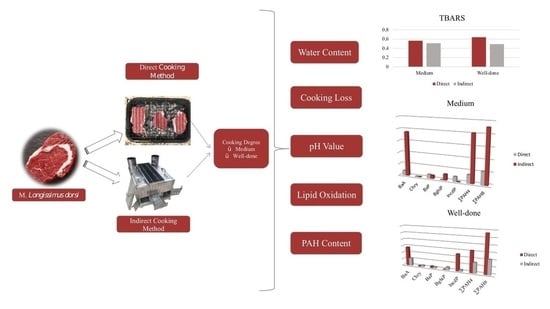Abstract
Herein, the effect of direct and indirect barbecue cooking processes, including different cooking degrees (medium and well done), on the formation of polycyclic aromatic hydrocarbons (PAHs) and on certain quality parameters (water content, cooking loss, pH, lipid oxidation) of beef meat was examined. While no significant effect (p > 0.05) of the cooking method was detected on the water content, cooking loss, ∑PAH4 [the sum of benzo[a]pyrene (BaP), benzo[a]anthracene (BaA), chrysen (Chry), and benzo[b]fluoranthene (BbF)], and ∑PAH8 [the sum of BaP, BaA, Chry, benzo[k]fluoranthene (BkF), dibenzo[a,h]anthracene (DahA), benzo[g,h,i]perylene (Bghip), and indeno [1,2,3-cd]pyrene (IncdP)] content, it was determined that it had a significant effect on pH (p < 0.05) and lipid oxidation (TBARS, p < 0.01). While the cooking degree did not have a significant effect (p > 0.05) on the TBARS value, it had a significant effect (p < 0.05) on the water content and pH value, and a very significant effect (p < 0.01) on the cooking loss. While BaA and BaP compounds were detected in all barbecued samples, the DahA compound could not be detected in any of the samples. Varying levels of BaA (up to 5.62 ng/g), Chry (up to 0.43 ng/g), BbF (LOD-..-LOQ), BkF (LOD-..-LOQ), BaP (up to 0.49 ng/g), BghiP (up to 0.82 ng/g), and IncdP (up to 4.99 ng/g) compounds were determined in the samples. While the ∑PAH4 contents varied between 0.71 and 6.35 ng/g, the ∑PAH8 contents varied between 1.12 and 11.34 ng/g. While the increase in cooking level did not affect the ∑PAH4 content, it caused a significant increase in the ∑PAH8 content. The highest BaP (0.49 ng/g), ∑PAH4 (6.35 ng/g), and ∑PAH8 (11.34 ng/g) contents were detected in the meat samples that were well cooked on the barbecue by the direct method. The results have proven that PAHs are formed at varying levels in both meat samples cooked on the barbecue by the direct method and the indirect method. On the other hand, it has been determined that even if 100 g of the meat with the highest BaP and ∑PAH4 content is eaten, the exposure amount remains far below the limit values specified for PAHs. However, paying close attention to the barbecue cooking process is still recommended.





